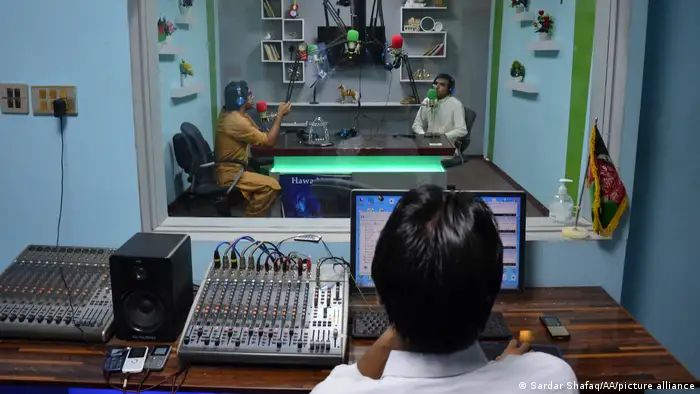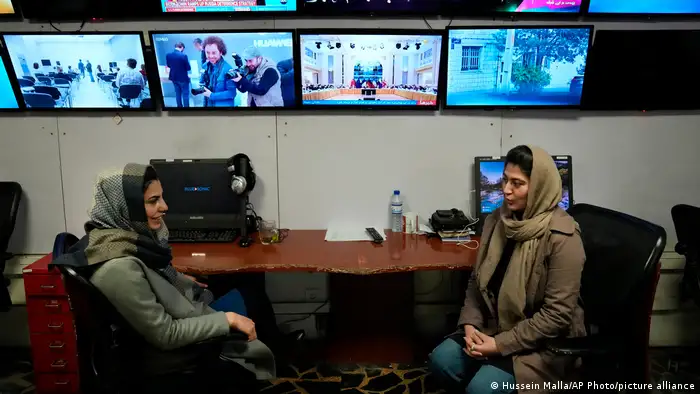#mediadev
Afghan media sector faces economic collapse
As journalists face repression under Taliban rule, the entire media sector is now falling apart, a study by DW Akademie finds.
"Previously, we had complete freedom to make programs, criticize and comment on the issues and needs of the people . . . Now there is no such thing as news, and it is tyranny and fear and limitation",
Anonymous respondent of DW Akademie's media survey on Afghanistan.
Since August 2021, the Afghan media sector has faced a brutal clampdown by the new Taliban authorities. At least 50 journalists and media workers have been arbitrarily detained since the Taliban took power, as stated by Reporters Without Borders, and the International Federation of Journalists reported that at least seven journalists were killed within three months following the Taliban takeover.
Against the backdrop of a highly precarious situation for journalists, a severe economic crisis is unfolding within Afghan media houses, according to a survey on the current state of the media sector in Afghanistan conducted by DW Akademie and partner organizations.
Data were collected in February 2022. 175 Afghan media professionals responded anonymously to an online survey (for details on the survey profile, see below). The results cast new light on the far-reaching changes within the sector. Half a year after the Taliban took power, most Afghan media houses are facing collapse.
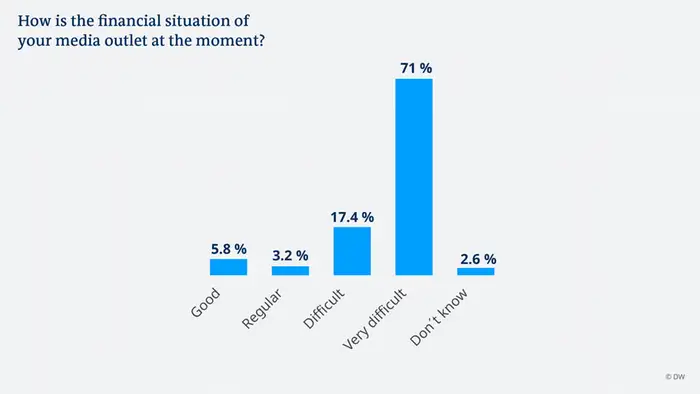
Results of an anonymous online survey among Afghan media workers with 175 respondents, conducted in February 2022. Sums might not add up to 100 percent due to rounding.
Afghan media outlets struggle to survive
Results of DW Akademie's study suggest that as journalists face dangerous working conditions, the deteriorating financial situation can also be considered one of the main reasons why more and more Afghan media outlets are ceasing operations.
Based on the perception of survey participants, 88 percent of the country's media outlets suffer from difficult to very difficult financial conditions, while only 8 percent are managing as normal financially, or doing well.
The economic situation within Afghan media houses is also exemplified by the indication of respondents that due to financial difficulties, almost 40 percent of media outlets are currently unable to pay any salaries at all. Over three quarters of survey participants see poor prospects for their media houses.
These findings correspond with other recent reports on the Afghan media environment. According to a survey published by Reporters Without Borders (RSF) and the Afghan Independent Journalists Association (AIJA), 40 percent of Afghan media houses have closed.
The International Federation of Journalists (IFJ) and the Afghan National Journalist's Union (ANJU) reported that since mid-August 2021, more than half of the 623 media houses that were active before the Taliban took control have stopped their activities.
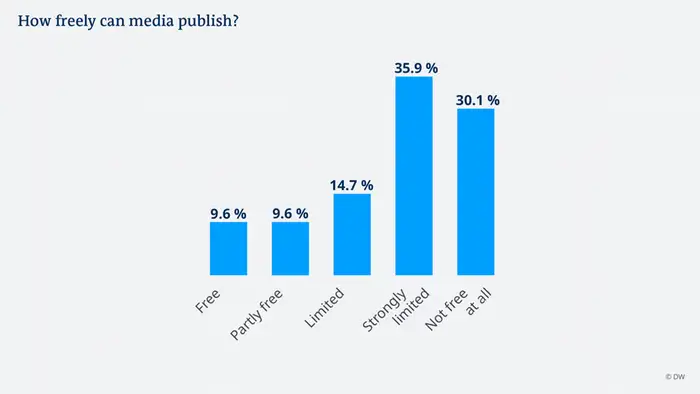
Results of an anonymous online survey among Afghan media workers with 175 respondents, conducted in February 2022. Sums might not add up to 100 percent due to rounding.
Censored reporting on politics, restricted entertainment
In light of widespread censorship and intimidation, DW Akademie's survey took a closer look at the topics and debates which are currently most affected by Taliban restrictions, while also seeking to identify any potential room for maneuver within journalistic reporting.
Two thirds of respondents to DW Akademie's survey affirmed that Afghan media houses cannot publish freely at all or only to a very limited extent. 85 percent of respondents said that openly conducted debates are currently very limited or not possible at all.
According to respondents, Afghan journalists and reporters are bounded to content that is favorable towards the Taliban and portrays them in a good light. Reports that criticize the previous government can also be published without risk. Uncritical social issues which are relevant to the overall public but unrelated to the Taliban government can also be reported on.
When asked which topics are most affected by changes in media programming since the Taliban took power, most respondents named reports about political issues, and entertainment. In many of the media houses that are still active, major program changes have taken place.
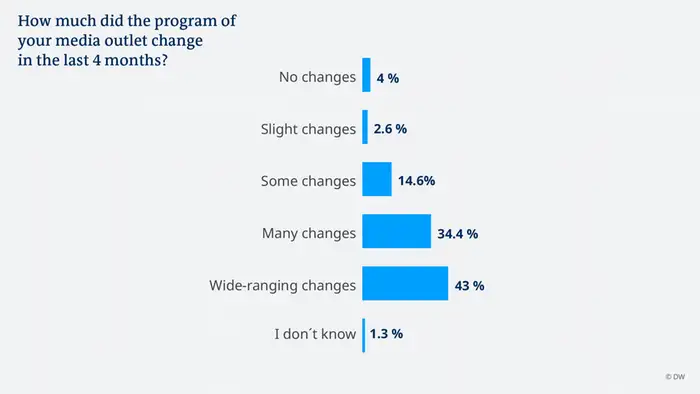
Results of an anonymous online survey among Afghan media workers with 175 respondents, conducted in February 2022. Sums might not add up to 100 percent due to rounding.
The Taliban restricted media coverage few weeks after their seizure of power. In September 2021, Taliban authorities announced "11 Rules for Journalism". Vaguely worded, the rules are deemed extremely dangerous as they can be used as a pretext to prosecute journalists.
In another directive issued in November 2021, the Taliban prohibited the broadcast of films that are "against Islamic or Afghan values" as well as soap operas and dramas with female actors. In addition, the Taliban's directive requires female television journalists to wear the hijab.
Laid off, unpaid, and threatened
Over 75 percent of survey respondents disclosed that they had been threatened verbally and/or physically since August 2021, reportedly half of them by the Taliban. 57 percent of respondents saw no choice but to flee their homes.
The precarious working conditions have put a heavy psychological burden on media professionals. Over three quarters of survey participants reported severe mental stress connected to anxieties and strong fears. Job insecurity and financial problems were the concerns most frequently stated.
The precarious job situation is exacerbated by reduced or unpaid wages. Just 13 percent of the active journalists surveyed by DW Akademie are paid by their media houses at present, with 65 percent stating that their wages cannot cover their expenses.
Six months after the fall of Kabul, half of the participants in DW Akademie's survey have lost their jobs. Women are disproportionately affected by job losses, with three quarters of respondents indicating that their media outlets do not employ female journalists anymore.
These figures are consistent with the data published by IFJ and ANJU. According to the organizations' report, only 46 percent of over five thousand journalists in the pre-Taliban era are still working, while only a quarter of female journalists are currently practicing their profession.
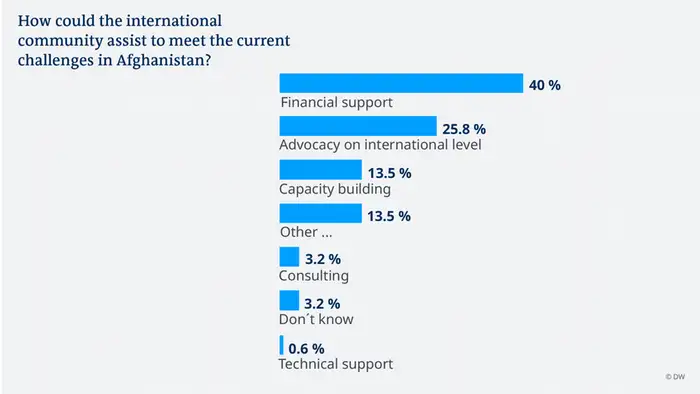
Results of an anonymous online survey among Afghan media workers with 175 respondents, conducted in February 2022. Sums might not add up to 100 percent due to rounding.
Afghan media professionals call on the international media development community for assistance
Rising job insecurity, financial instability, intimidation, violence, and arbitrary arrests have jeopardized the psychological and physical safety of Afghan media representatives and their families.
While international media undoubtedly have a vital role to play in the distribution of uncensored information in this highly volatile situation, Afghan media professionals also call on the international media development community to provide assistance on various levels.
Within the context of DW Akademie's survey, 40 percent of participants stated that providing financial support was the best way for the international community to help in the face of current challenges. Advocacy measures on the international level were also rated as particularly meaningful by one quarter of respondents.
Notably, journalists and reporters, as compared to media managers, positioned themselves more favorably towards the international community engaging in advocacy for media freedom in Afghanistan.
Survey Profile
Data were collected in an anonymous online survey in February 2022. The semi-standardized questionnaire included 55 questions and was completed by 175 respondents, in Dari (65.4%), Pashto (23.8%), and English (10.7%). Only 7.2 percent of participants were female. The survey largely represents media managers (51.5%), followed by journalists (21%), reporters (19.8%), and others. Most respondents (78.4%) work for smaller media houses with fewer than 50 staff members. As for media outlets, radio and TV stations are primarily represented (69.5% in total). Most media respondents are privately funded (39.7%), followed by those financed through public funding (9.6%), international sources (9%), and government funding (5.1%). Overall, advertising revenues are the predominant source of income (63.5%).
DW recommends
- Date 06.04.2022
- Author Gregor Barié, Elena Köhler
- Feedback: Send us your feedback.
- Print Print this page
- Permalink https://p.dw.com/p/49JxN
- Date 06.04.2022
- Author Gregor Barié, Elena Köhler
- Send us your feedback.
- Print Print this page
- Permalink https://p.dw.com/p/49JxN

